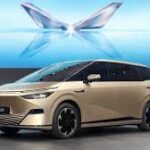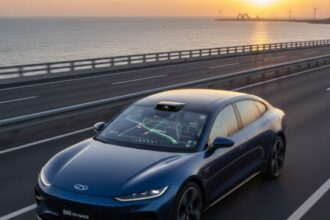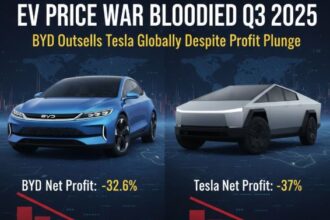Kia has officially launched a new version of its EV5 electric SUV tailored specifically for the European and Canadian markets. This updated model notably replaces the BYD-sourced Blade battery with a different battery technology and includes several other interesting changes. Let’s dive into what this means for Kia fans and potential EV buyers in these regions.

A Strategic Shift in Production and Battery Technology
The Kia EV5 was originally introduced in China in November 2023, where it has enjoyed surprisingly strong sales thanks to its competitive price and solid performance. However, the version now destined for Europe and Canada is not simply a direct import. Instead, Kia has wisely moved production of these regional models to South Korea. This move is strategic, designed to avoid tariffs imposed on Chinese-made vehicles in these markets.
Because the European and Canadian EV5s are now produced in South Korea, they no longer use BYD’s Blade lithium iron phosphate (LFP) battery. Instead, Kia has equipped these models with an NMC (nickel manganese cobalt) battery pack. This switch is significant, as it changes the chemistry and potentially the performance characteristics of the battery system.
Battery Capacity and Range: What to Expect
The upgraded EV5 comes with an 81.4 kWh battery, delivering a WLTP-rated range of around 329 miles (531 kilometers). Interestingly, this range is roughly equivalent to the BYD Blade battery version, which raises some questions. Typically, NMC batteries offer higher energy density than LFP batteries, so one might expect a noticeable improvement in range. However, Kia’s choice seems to result in similar real-world performance.
There is also a smaller battery option available—a 60.3 kWh pack—though exact range figures for this variant have not been disclosed yet.
Performance and Charging Features
The EV5 is built on a 400V platform rather than the more advanced 800V architecture found in some newer EVs. While this helps keep manufacturing costs down, it does limit charging speed to some extent.
Despite this, the EV5 offers an improved charging rate, capable of going from 10% to 80% charge in about 30 minutes. The powertrain is a front-wheel-drive setup producing 215 horsepower (160 kW) and 218 lb-ft (295 Nm) of torque. These figures are modest but adequate for everyday driving.
One notable feature is the inclusion of bidirectional charging, allowing the EV5 to supply power back to a home or grid (vehicle-to-load) at up to 3.6 kW. Whether vehicle-to-grid (V2G) functionality is available depends on local regulations, but the hardware capability is there.

Design and Interior Comfort
The EV5 sports a fairly traditional, boxy SUV design—much more conventional compared to some of the more futuristic electric SUVs on the market. This classic styling likely contributes to its popularity, as many buyers appreciate the familiar look that resembles internal combustion SUVs.
In terms of size, the EV5 is smaller than popular competitors like the Tesla Model Y or the BYD Tang (Line 7). At 4.6 meters (181.5 inches) long, it’s closer in size to the Hyundai Ioniq 5, which means interior space is more limited compared to larger rivals.
Inside, Kia has created what it calls a “loungelike environment” focused on comfort. The seats come with massage functions, heating, and ventilation. The dashboard features Kia’s new CCNC connect car navigation cockpit infotainment system, which includes two 12.3-inch displays for the instrument cluster and infotainment, plus a 5.3-inch screen for climate controls.
While the panoramic horizontal display looks striking, it may not be the most practical for navigation, especially in dense urban areas. Some drivers find it harder to follow directions on these wide screens compared to more vertically oriented displays found in vehicles like the Tesla Model Y or XPeng G6.
Price and Market Positioning
Since the European and Canadian EV5s are produced in South Korea, prices are expected to be slightly higher compared to the Chinese-made versions. The EV5 is positioned as a premium offering in a competitive segment, and it is priced above many rivals despite its relatively smaller size.
Kia Europe’s COO emphasized the importance of the EV5, calling it a “cornerstone of Kia’s European growth strategy” and highlighting its suitability for European lifestyles and driving habits.
The Major Drawback: Efficiency Concerns
One of the biggest issues raised by reviewers, including myself, is the EV5’s efficiency. Real-world testing shows the vehicle consumes around 21 kWh per 100 km, which is significantly less efficient than competitors of similar or even larger size. For comparison, vehicles like the Tesla Model Y and XPeng G6 typically achieve 15 to 16 kWh per 100 km under similar conditions.
This efficiency gap means the EV5 uses considerably more energy to cover the same distance, which could translate into higher running costs and more frequent charging stops for some drivers.
Who Should Consider the Kia EV5?
Despite its efficiency drawbacks, the EV5 still makes sense for a specific group of buyers—namely, Kia brand enthusiasts. If you are loyal to Kia and are considering switching from an internal combustion or hybrid Kia to an EV, the EV5 is a solid option with good comfort and a familiar driving experience.
However, if you are open to exploring other brands and prioritize efficiency, range, and interior space, there are better options available at similar price points.
Final Thoughts
The new Kia EV5 for Europe and Canada represents an important strategic move by Kia to adapt to regional market and tariff requirements. The switch to an NMC battery and the relocation of production to South Korea are key changes that affect the vehicle’s specs and pricing.
While the EV5 offers solid range, decent charging speeds, and a comfortable interior, its lower efficiency compared to rivals is a notable downside. Ultimately, it will appeal most to Kia fans and those looking for a traditional SUV design with modern electric capabilities.
For more insights and detailed reviews on electric vehicles, stay tuned to expert voices in the EV community.




